A Primer
Maybe you've never heard of Digital Matter Theory OR M-Theory, and that's ok. Here's an overview of what we'll cover.
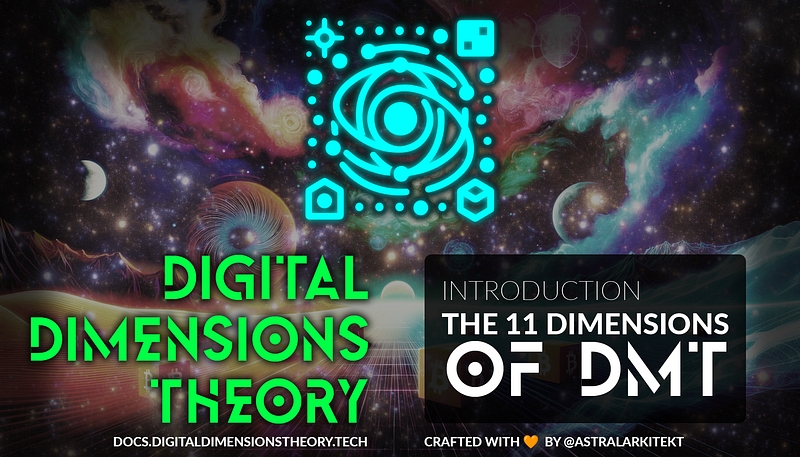
“We are like butterflies who flutter for a day and think it is forever.” -Carl Sagan
Ordinals introduced me to a whole new world of thrills. Bitmap — a whole new universe. Digital Matter Theory (DMT)? After three months studying, experimenting, and now preparing my first UNAT Collection, as well as an arbitrarily-supplied collection of DMT-Enhanced Gamified 3D Bitmap Collectibles, I think my biggest takeaway is this:
We’re not looking at just a Bitmap Metaverse. We’re looking at Ordinals on the whole as microcosmic digital multiverses when viewed through the lens of Digital Matter Theory with a Digital Dimensions Theory (DDT) twist. And I want to show you how to tap into that potential so that you can bring your visions to fruition.
Bitmap and Ordinals need builders. What we build — the masses will one day consume. What we build lowers the barriers to entry and understanding through the creation of memorable, innovative, immersive, and interactive experiences.
As Carl Sagan said so poetically above, we often see only a small part of the grand tapestry of existence. Similarly, we are just beginning to glimpse the vast potential of digital constructs within Bitcoin ordinals. So...
What IS Digital Dimensions Theory?
How can it help you build better, faster, and more creatively?
Digital Dimensions Theory (DDT) is a creative framework designed to complement Digital Assembly Theory (DAT) and Digital Matter Theory (DMT) in their applications. By using DDT as a creativity toolset, you engage in thought experiments and interact with practical tools that make the application of DMT tangible. This process helps you achieve project milestones step by step, transforming your visions into reality.
It came from a thought experiment — What happens when you combine Digital Matter Theory (DMT) with M-Theory — A theoretical physics framework for understanding all of nature, gravity, everything. It posits 11 dimensions — 10 + time. Does it work? Does it inspire? Does it help me take action?
Yes! It does, and I’m proving it day in and day out as I build The Void Mosaics, The VOID Veil Trials on-chain Cosmic Card Battler, and my upcoming UNAT project — NATGalaxies (WIP).
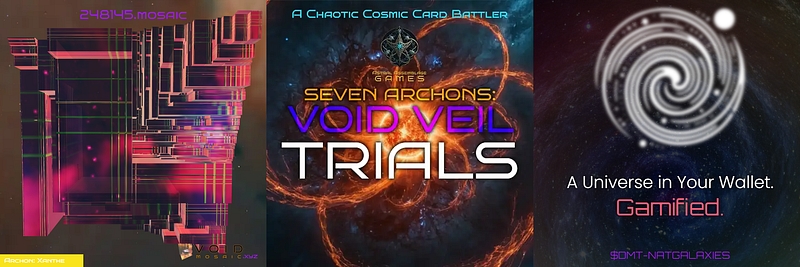
Now, this is a Creativity Framework and set of Tools. I’m not going to try and teach you M-Theory — that’s above my pay grade and not my expertise.
So why should you care about this weird Blue-Robed Alien Robot, called Astral (jk jk) — but why should you trust me to teach you this?
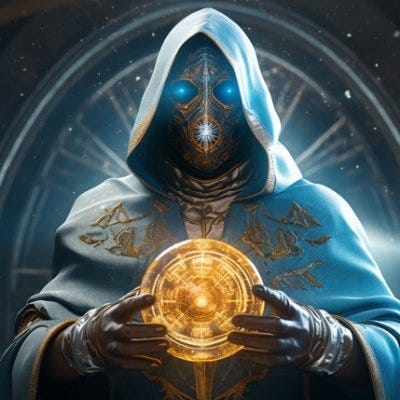
Who is Astral Arkitekt? And who am I to teach this?
I am a software developer with 24 years of experience in front and backend web platforms. I’ve self-taught everything I know and currently run the front-end publishing pipelines for a major musical instrument manufacturer.
In 2016, I rediscovered my childhood passion for painting and began producing music. I spent the year learning music production, guitar, and various painting techniques. Over the past 8 years, I’ve created over 300 paintings, written, performed, recorded, and produced 488 songs, and released two full-length studio albums with a third on the way.
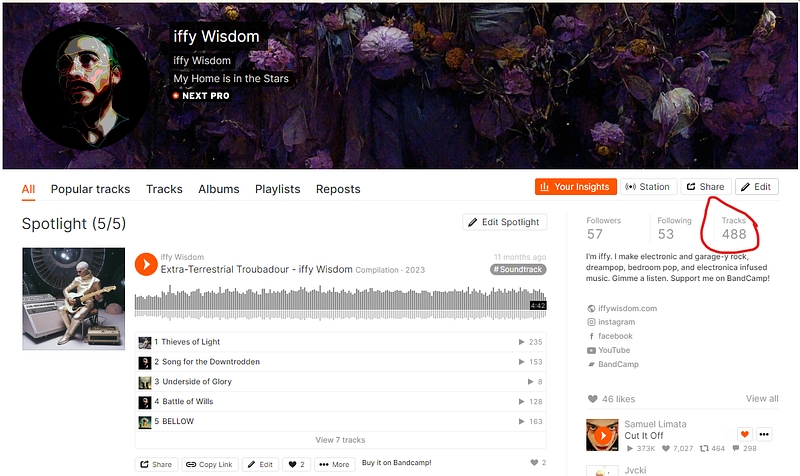
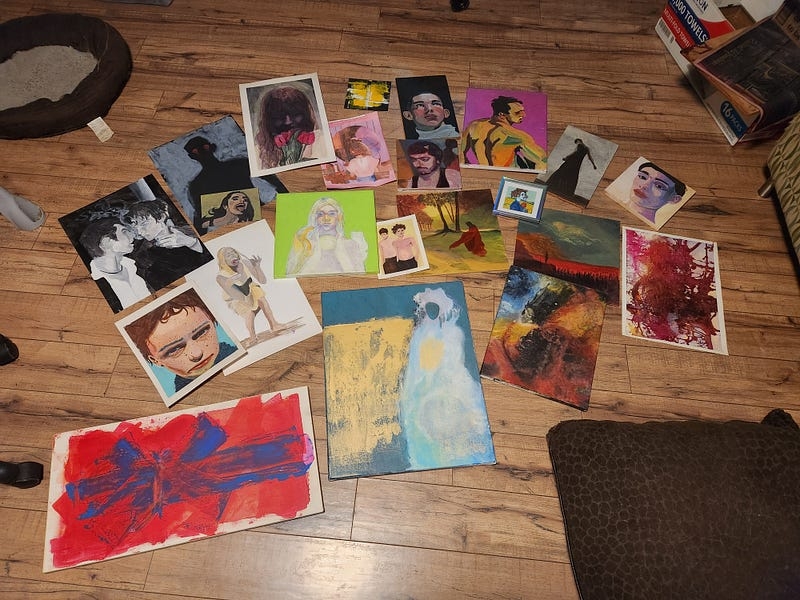
I’ve put in the grind for 8 years. I’ve earned my 12k+ hours by always creating before and after work nearly every day for the past 8 years. I’ve done it all by way of applying Creative constraint. I even made a songwriting game called “Under the Influence” teaching creative constraint for songwriters, and it’s had really positive feedback.
Throughout my journey, one constant has kept me productive and it is the cornerstone of Digital Dimensions Theory: Creative Constraint.
What is Creative Constraint and Why Should You Use It in Your Projects?
Momentum is key in any creative endeavor, and creative constraint is the fuel for momentum. In my studio, it’s not uncommon for 7pm to arrive, signaling time for art, music, or writing, and I have no ideas. But I don’t let that stop me. Creative constraint alleviates a lot of the decision-making that can lead to pauses in progress by providing a pre-determined menu of options to select from. This helps maintain momentum and keeps the creative process flowing.
Sounds a lot like selecting traits from your DMT Dataset doesn’t it? 🙃
If that sounded like Greek to you, please hit up mScribe’s Gitbook on Digital Matter Theory — it’s essential that you have a solid understanding of non-arbitrary data, a slight familiarity with block data from bitcoin using what’s know as Recursion. (Outside the scope of this article, but I’ve linked to the docs on it!)
Exploring the Dimensions: Applying M-Theory to Digital Creativity
Now, it’s been my experience this last 3-months working daily with Digital Matter Theory’s principles of Non-Arbitrary trait selection that Creative Constraint takes a bit more work than with songwriting, so I got to thinking about M-Theory and how it is a set of constraints.
Each dimension in M-Theory corresponds to a different “level” or aspect of creating digital art, games, music, and other experiences.
Each Dimension in the Digital Dimensions Theory creativity framework poses a Thought Experiment, Actions to take, tools to consider, and examples of how to apply this theory to your project to get your brain-juices flowing.
Ready to dive in? LET’S GOOOOOOOO! 👨🚀🚀🌌
The 11 Dimensions of DMT
DMT-0: The Point
Concept: The most fundamental level, representing a single, discrete data point or element. Application: Discover your sparks. Your dreams and visions for projects. Look at other projects and discover what you love about them. Explore these ideas. Number them in a list.
Then surrender to the fate of bitcoin.
Observe the blockinfo for your favorite bitmap, or if it’s too hard to choose? Select the most recently confirmed block.
Go to the timestamp and copy that to your clipboard.
Now perform a Modulo operation on that timestamp (first number) using the number of Ideas you wrote down as the Factor (second number).
The result — that’s the idea you’re going to explore. We’ll cover this in more detail in the next lesson, as well as provide you some resources and example scenarios to reinforce what you’ve learned.
DAT-1: The Line
Concept: Connecting individual points to form a linear sequence. Application: Explore your dataset. Identify the traits you want DMT to express for you. Draw lines — dotted ones from your Data points to your traits that those data points express. We’re experimenting, not deciding. We’re having fun. We’re playing — “what happens when…” 😊
DAT-2: The Plane
Concept: Expanding linear sequences into a two-dimensional grid. This is where most examples of UNATs live. DMT-2 — The Plane. 2D art happens here. Application: Form patterns and connections by mapping data points onto a 2D plane, such as creating generative art from Bitcoin bits field values. We’ll start with several techniques to select the background color and move on to simple shapes, outlining the path to recreating a very popular generative art collection I think all of us in the space know and respect. 😉 Tools included!
DAT-3: The Space
Concept: Adding depth to create three-dimensional structures. Application: We will discuss the move from 2-dimensional space, and the tools available to begin experiencing, experimenting and thinking in Non-Arbitrary 3D space. We’ll talk tech, learning resources, and tools from within the community and the world at large.
DAT-4: The Event (Time)
Concept: Incorporating the dimension of time, allowing constructs to evolve. Application: Animate or sequence events over time, creating dynamic and evolving digital constructs. Learn to implement modular recursion in your Inscription’s design to create both deterministic and arbitrary events that occur when certain data conditions are satisfied within the block you’re working with. This is gonna be 🔥
DAT-5: The Branch (Alternate Realities)
Concept: Here we begin to enter some very interesting territory, exploring alternate possibilities branching off from the main timeline. This blew my mind when I discovered this technique and implemented the algorithm to make this happen. Application: Learn to develop multiple versions of a project within the same scripts, each following a different path or scenario based on initial conditions. Tools, Examples, Code Snippets — we’re gonna try and provide all for you. I shouldn’t be the only person with these tools, they’re too cool.
DAT-6: The Timeline (Meta-Possibilities)
Concept: Visualizing all possible timelines of a universe. Application: Generate dynamic maps of all potential outcomes, illustrating the full range of possibilities for a project. This is a heavy topic, not for the faint of heart, but the practical implementation will drive the learnings home leaving you with thought exercises, tools, and code to help you get there if it fits with your next project.
DAT-7: The Multiverse (Different Initial Conditions)
Concept: Examining different initial conditions across multiple universes. Application: Create parallel versions of a project with varying starting points, exploring how different conditions affect outcomes. My practical example for this will dive into my NATGalaxies Project to showcase some of the rarities that occur within my collection that make use of the idea of the Multiverse. There will be lore. There will a Universe to Explore. And you will be left lost in thought if I have anything to say about it! — In a good way!
DAT-8: The Rule Set (All Possible Laws of Physics)
Concept: Considering all possible laws of physics within a construct. Application: Experiment with different rule sets or constraints to see how they alter the behavior and interactions within a digital environment. In this section we’ll discuss the efffects of physics and how our worlds and lives are changed by tiny shifts in what we know as immutable laws. When you’re in the multiverse, hopping from one Universe to the next, who’s to say time moves in the same direction? Who’s to say Carbon was the basis of life? The possibilities my friends will light your mind’s on fire when you learn to contemplate the 8th Dimension of Digital Matter Theory and this little thing we know as reality. We’re gonna have fun here.
DAT-9: The Comparison (Comparing Different Physical Laws)
Concept: Comparing different sets of physical laws across universes. Application: Analyze and compare the effects of varying rules or conditions on different versions of a project to understand their impact. I’m very excited for this lesson and discussion because this is where we take a look at some cool game theory as a practical example of how to implement this. I hope somebody builds my use-case for real or maybe someone in the community will know of a game that already exists. But we’re gonna mess with physics. It’s gonna be great. And don’t worry — this is a conceptual learning with a practical example. Not highly technical. We’ll engage in thought experiments, and hopefully some tools to help you with this higher level Digital Matter Theory concept where we Mix Physics of Multiple Universes together to create truly unique art, and other types of experiences.
DAT-10: The Never Ending Stories (Infinite Possibilities)
Concept: Representing infinite possibilities and unifying all realities. Application: We’ll discuss what we’ve learned between DMT-0 up to here, then we’ll engage in thought experiments that open up the 11th dimension (DMT-10) before your very eyes. Revealing truly breathtaking scope applied to gaming. When I reached this level of DMT in my research, I had to take break. I thought no way I can come to an implementation that works like this. But this is a cumulative Dimension we’re messing with here. The path that led us here matters just as much as each step that carried to this — the pinnacle. The never-ending story of Bitcoin.
Conclusion: Join the Journey
Thank you for exploring Digital Dimensions Theory with me! Your support and engagement are invaluable as we dive deeper into the realms of creativity and digital innovation.
Stay Connected
Follow me on X: @astralarkitekt
Join the Discussion on Discord: Digital Dimensions Theory Discord
Special Thanks
A huge shout-out to Bitmap creator Bitoshi Blockamoto for providing the spark that created the concept of Digital Matter Theory. If he'd not taught us to look at Bitcoin Block Data from different angles, and use it as the source of Creative Constraint in defining Bitmap, I don't think we'd have Digital Matter Theory.
Thank you to Will and Iman at The Block Runner Podcast / mScribe for setting my mind on fire with Digital Matter Theory.
To the Bitmap community: Your welcoming and open-minded spirit has been a beacon of inspiration.
Special thanks to @elevateddabber for sparking my journey down this road with his thought-provoking article, “You Live In A Bitmap”
Let’s continue this journey together, pushing the boundaries of what’s possible with Bitcoin ordinals and digital creativity. Thank you for being part of this incredible adventure! 🚀✨
P.S. You can checkout my ultimate goal at https://AstralAssemblage.com. I make Cosmic Strategy Card Games, Fiction, Music and more set in this Multiverse!
Last updated